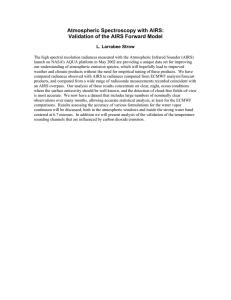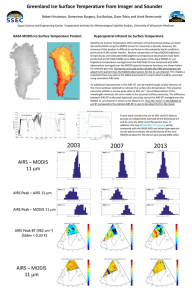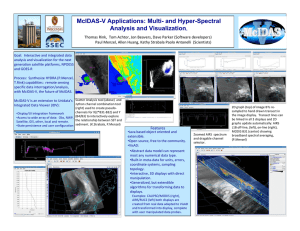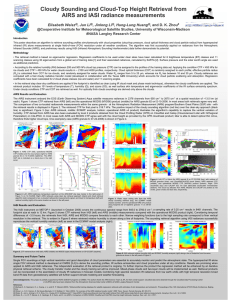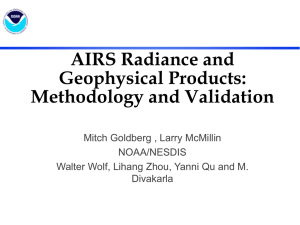Synergistic use of high spatial resolution imager and high
advertisement
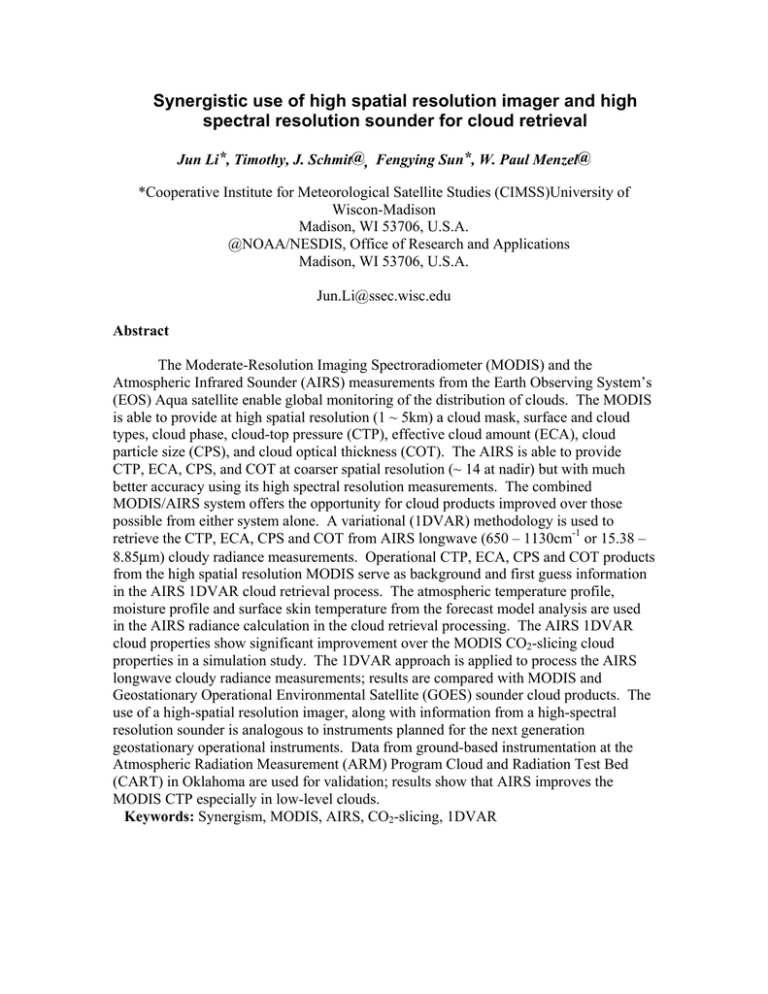
Synergistic use of high spatial resolution imager and high spectral resolution sounder for cloud retrieval Jun Li*, Timothy, J. Schmit@, Fengying Sun*, W. Paul Menzel@ *Cooperative Institute for Meteorological Satellite Studies (CIMSS)University of Wiscon-Madison Madison, WI 53706, U.S.A. @NOAA/NESDIS, Office of Research and Applications Madison, WI 53706, U.S.A. Jun.Li@ssec.wisc.edu Abstract The Moderate-Resolution Imaging Spectroradiometer (MODIS) and the Atmospheric Infrared Sounder (AIRS) measurements from the Earth Observing System’s (EOS) Aqua satellite enable global monitoring of the distribution of clouds. The MODIS is able to provide at high spatial resolution (1 ~ 5km) a cloud mask, surface and cloud types, cloud phase, cloud-top pressure (CTP), effective cloud amount (ECA), cloud particle size (CPS), and cloud optical thickness (COT). The AIRS is able to provide CTP, ECA, CPS, and COT at coarser spatial resolution (~ 14 at nadir) but with much better accuracy using its high spectral resolution measurements. The combined MODIS/AIRS system offers the opportunity for cloud products improved over those possible from either system alone. A variational (1DVAR) methodology is used to retrieve the CTP, ECA, CPS and COT from AIRS longwave (650 – 1130cm-1 or 15.38 – 8.85µm) cloudy radiance measurements. Operational CTP, ECA, CPS and COT products from the high spatial resolution MODIS serve as background and first guess information in the AIRS 1DVAR cloud retrieval process. The atmospheric temperature profile, moisture profile and surface skin temperature from the forecast model analysis are used in the AIRS radiance calculation in the cloud retrieval processing. The AIRS 1DVAR cloud properties show significant improvement over the MODIS CO2-slicing cloud properties in a simulation study. The 1DVAR approach is applied to process the AIRS longwave cloudy radiance measurements; results are compared with MODIS and Geostationary Operational Environmental Satellite (GOES) sounder cloud products. The use of a high-spatial resolution imager, along with information from a high-spectral resolution sounder is analogous to instruments planned for the next generation geostationary operational instruments. Data from ground-based instrumentation at the Atmospheric Radiation Measurement (ARM) Program Cloud and Radiation Test Bed (CART) in Oklahoma are used for validation; results show that AIRS improves the MODIS CTP especially in low-level clouds. Keywords: Synergism, MODIS, AIRS, CO2-slicing, 1DVAR 1. Introduction The Atmospheric Infrared Sounder (AIRS) (http://www-airs.jpl.nasa.gov) (Aumann et al. 2003) on NASA’s Earth Observing System (EOS) Aqua satellite is a high spectral resolution (ν/∆ν = 1200) infrared sounder with 2378 channels, measuring in the infrared region 3.74 – 15.4 µm, that obtains the vertical profiles of atmospheric temperature and water profiles from the Earth’s surface to an altitude of 40km. AIRS provides infrared information at a 13.5 km horizontal resolution at nadir. Taking advantage of high spectral resolution AIRS longwave cloudy radiance measurements, CTP and ECA can be retrieved with better accuracy than with MODIS. A scheme called Minimum Local Emissivity Variance (MLEV) (Huang et al. 2003a) has been tested for retrieving the CTP and ECA from high spectral resolution sounder radiances; the scheme seeks the CTP solution with minimum local cloud emissivity variance. However, MLEV is not appropriate for operational processing due to its considerable computational requirements; overcast radiance calculations are needed from upper- to low-level clouds for each longwave channel in order to seek the minimum. The CO2-slicing algorithm can also be applied to retrieve CTP and ECA from AIRS radiances; however, it is difficult to select pairs from high spectral resolution sounder channels and give proper weight to each pair (Antonelli 2001; Smith and Frey 1990). 1DVAR, using an iterative approach to find the solution, provides an efficient way for cloud retrieval using high spectral resolution sounder longwave cloudy radiance measurements. Since an AIRS independent background and first guess are needed in the 1DVAR approach, the 5km MODIS cloud product is an obvious choice. MODIS (http://modis.gsfc.nasa.gov/about/specs.html) is a key instrument on the EOS Terra and Aqua satellites for conducting global change research. It provides global observations of Earth's land, oceans, and atmosphere in 36 visible (VIS), near infrared (NIR) and IR regions of the spectrum from 0.4 to 14.5 µm. MODIS cloud products (http:/modis.gsfc.nasa.gov/data/dataproducts.html) include, but are not limited to, the cloud mask (Ackerman et al. 1998) which provides each MODIS 1km pixel with a clear index (confident clear, probably clear, confident cloudy, probably cloudy), cloud phase with 1km resolution which provides each MODIS 1km pixel a phase index (water clouds, ice clouds, mixed phase, etc.), CTP and ECA from MODIS CO2 band measurements with 5km spatial resolution, along with CPS and COT with 1km spatial resolution (King et al. 2003; Platnick et al. 2003). The 1DVAR algorithm simultaneously accounts for the instrument noise, uncertainties of the radiative transfer model, atmospheric temperature and moisture effects, and the satellite cloudy measurements. Since all longwave CO2 spectral cloudy radiances are (a) inversely weighted by their instrument noise along with the assumed forward model error and (b) used simultaneously in the 1DVAR retrieval processing, noticeable improvements in 1DVAR cloud retrievals were found over the CO2-slicing cloud parameters (Li et al. 2001). A fast and accurate radiative transfer model called Stand alone AIRS Radiative Transfer Algorithm (SARTA) (Hannon et al. 1996; Strow et al. 2003; http://asl.umbc.edu/pub/rta/sarta/) was used for AIRS clear sky atmospheric transmittance calculation. In order to account for the scattering and absorption effects of ice clouds and water clouds in radiances, a fast radiative transfer cloudy model for hyperspectral IR sounder is being developed through the joint efforts of University of Wisconsin-Madison and Texas A&M University. In the fast cloudy radiative transfer model, a single scattering of ice cloud under the assumption of hexagonal for large particles and droxtals for small particles is used (Yang et al. 2001; 2003). For water clouds, spherical water droplets are assumed, the Lorenz-Mie theory is used to calculate the single-scattering properties. The cloud microphysical properties are described in terms of cloud particle size (CPS) or effective cloud particle radius and visible cloud optical thickness (COT). Given the visible COT and CPS, the IR COT, single-scattering albedo, and asymmetry factor can be parameterized for radiative effects of ice clouds and water clouds. The cloudy radiance for a given AIRS channel can be calculated by combining the clear sky optical thickness from SARTA and the cloud effects by adding a COT, single-scattering albedo, and scattering phase function. Studies show that the slope of an IR cloudy BT spectrum between 790 (12.6 µm) and 960 cm-1 (10.4 µm) is sensitive to the CPS, while the cloudy radiances are sensitive to COT in the region of 1050 (9.5 µm) – 1250 cm-1 (8 µm) for ice clouds (Huang et al 2003b). Synergistic use of high spatial resolution MODIS cloud products and AIRS longwave cloudy radiance measurements, described in this paper, can be applied to process EOS direct broadcast MODIS/AIRS data. These techniques will be relevant to data from the Visible Infrared Imaging Radiometer Suite (VIIRS) and Cross-track Infrared Sounder (CrIS) - VIIRS / CrIS on the National Polar Orbiting Environmental Satellite System (NPOESS), and relevant to data from the Advanced Baseline Imager (ABI) (Schmit et al. 2002) and Hyperspectral Environmental Suite (HES) system – ABI / HES on the GOES-R (Gurka and Schmit 2002). 2. The 1DVAR retrieval scheme The 1DVAR algorithm for AIRS CTP, ECA retrievals uses the MODIS CO2slicing derived CTP, ECA, CPS and COT as background and first guess information to calculate the nonlinear optimal solution of cloud parameters from the AIRS longwave spectral band cloudy radiance measurements. AIRS channels with wavenumbers between 700 and 790 cm-1 are used in the CTP and ECA retrieval, while those channels with wavenumbers between 790 and 1130 cm-1 are used for CPS and COT retrieval. Given the AIRS observed cloudy radiance, R , for each channel, then R = R(T , q, Ts , ε s , p c ,Nε c , De , OT ) (the fast cloudy radiative transfer calculation) which has the form Y = F( X ) , (1) where the vector X contains the CTP, ECA, CPS and COT (the atmospheric temperature profile, moisture profile, surface skin temperature and infrared surface emissivity are assumed to be known or obtained from the forecast model analysis), and Y contains N satellite observed cloudy radiances. The linear form of Eq. (1) is δY = F ' ⋅ δX , (2) ' where F is the linear or tangent model of the fast cloudy forward model F . The 1DVAR approach is to minimize a penalty function J ( X ) , which measures how well the radiance measurements fit the background information, and possibly to other physical constraints. A general form of the 1DVAR solution (Rodgers 1976; Eyre 1989) is given by J ( X ) = [Y m − Y ( X )]T E −1 [Y m − Y ( X )] + [ X − X B ]T B −1 [ X − X B ] , (3) where the vector X contains the CTP, ECA, CPS and COT that need to be solved. Since ECA is spectrally dependent, ECAs at ten wavenumbers (710, 720, 730, 740, 750, 760, 770, 780, 790, 800 cm-1) are retrieved, and ECA for a given channel will be obtained by linear interpolation from these ten ECAs. X B is the background information inferred from the MODIS operational products, Y m is the vector of the AIRS measured cloudy radiances used in the retrieval process, Y ( X ) is a vector of cloudy radiances calculated from the cloud state X , E is the observation error covariance matrix which includes instrument noise plus the assumed forward model error, and B is the assumed background error covariance matrix which constrains the solution. To solve Eq. (3), a Newtonian iteration is used X n +1 = X n + J '' ( X n ) −1 ⋅ J ' ( X n ) , (4) and the following quasi-nonlinear iterative form (Eyre, 1989) is obtained T T δX n+1 = ( Fn' ⋅ E −1 ⋅ Fn' + B −1 ) ⋅ Fn' ⋅ E −1 ⋅ (δYn + Fn' ⋅ δX n ) , (5) where δX n = X n − X B , δYn = Y m − Y ( X n ) . The AIRS channels with wavenumbers between 700 and 790 cm-1 are used for CTP and ECA retrieval while the IR longwave window channels with wavenumbers between 790 and 1130 cm-1 are used for cloud microphysical property (CPS and COT) retrieval. The measurement error covariance matrix, E , is a fixed diagonal matrix, where each diagonal element is the square of the AIRS instrument noise plus an assumed forward model error of 0.2 K for each longwave channel. The first guess X 0 , or the starting point of the iteration in Eq.(5), are also the MODIS CTP and ECA products. 3. Retrieval results A granule of AIRS data was studied. Figure 1 shows the AIRS longwave window (906cm-1) brightness temperature (BT) images at 19:17 UTC 6 September 2002, the red color indicates warm scene or clear skies, while the blue color represents cold scene or cloudy skies. Collocated MODIS data were used for the AIRS CTP and ECA retrieval study. Radiances from 14 MODIS spectral bands are used to estimate whether a given view of the Earth surface is affected by clouds, aerosol, or shadow (Ackerman et al. 1998). The AIRS footprint is determined to be cloudy for cloud retrieval only when the percentage of the clear MODIS pixels within the AIRS footprint is less than 10%. The atmospheric temperature and moisture profiles as well as the surface skin temperature are taken from the European Center for Medium-range Weather Forecasting (ECMWF) forecast model analysis in the 1DVAR retrieval. A2 A1 A3 Figure 1. The AIRS longwave window channel (906cm-1) BT image at 19:17 UTC 6 September 2002 (AIRS granule 193). In each iteration, the CTP is limited to 115 hPa for the highest and 1000 hPa for the lowest, while the ECA must be between 1.0 and zero. Only AIRS longwave channels with observed minus calculated brightness temperatures (BT) greater than 3 times the instrument noise are used in the 1DVAR; 1DVAR will not be attempted if less than 5 AIRS channels are found. Each AIRS granule has 135 scan lines and each scan line has 90 footprints. In the selected granule, 6332 AIRS footprints were detected to be cloudy. 5232 had successful cloud retrievals (83%). For the remaining 1100, the residual between measured and calculated (from the MODIS CTP and ECA background information) brightness temperatures was too small (8%) or the cloud retrieval failed to converge (9%); nonconvergence occurred primarily in multi-layer cloud conditions as estimated by the MODIS classification (Li et al. 2003a). Figure 2 shows the study area A1 (Lake Michigan area, see Figure 1 for the location of the study area A1). Footprints F1 and F2 view ice clouds in partly cloudy conditions. Figure 3 shows the AIRS longwave clear BT calculation from the ECMWF forecast model analysis (yellow line), cloudy BT calculation with the MODIS CTP and ECA (green line), the BT calculation with the AIRS retrieved CTP and ECA (blue line), and the BT calculation with the AIRS retrieved CTP, CPS and COT (red line), as well as the cloudy BT observation (black line) spectra for AIRS footprint F1 (upper panel). Again, the MODIS cloud products are used as the background and first guess information in the AIRS retrieval. The lower panel shows the corresponding BT difference between the observation and the calculation (Obs – Cal). Figure 3 indicates that AIRS produces only slight changes in the MODIS CTP in this very thin cloud case of footprint F1; however, AIRS changes the MODIS ECA by 0.05 which results in a significant BT differences. Although the calculation with AIRS retrieved CTP and ECA fits the observation very well in the CO2 region (650 – 790 cm-1), there is still a discrepancy between the calculation and observation in the longwave IR window region (900 – 1130 cm-1, or 8.8 – 11 µm) due to the scattering of ice clouds. F1 F2 Figure 2. The study area A1 (Lake Michigan area, see Figure 2 for the location of the study area A1) of the MODIS classification mask collocated to the AIRS footprints. Figure 3. The AIRS longwave clear BT calculation from the ECMWF forecast analysis (yellow line), cloudy BT calculation with the MODIS CTP and ECA (green line), the BT calculation with the AIRS retrieved CTP and ECA (blue line), and the BT calculation with the AIRS retrieved CTP, CPS and COT (red line), as well as the cloudy BT observation (black line) spectra for AIRS footprint F1 (upper panel). The lower panel shows the corresponding BT difference between the observation and the calculation (Obs – Cal). With determined CTP, the CPS and COT can be retrieved simultaneously from 800 (12.5 µm) – 1130 cm-1 (8.8 µm) with also the variational approach. Again, the MODIS CPS and COT products serve as the background and first guess information. Calculations that include the AIRS estimates of CPS and COT fit well to the observations for all AIRS longwave channels (see the red line in Figure 3). Figure 4 is the same as Figure 3 but for footprint F2 that has more ice cloud cover. The AIRS radiance measurements raise the MODIS CTP by 17 hPa, while they decrease the MODIS ECA by approximately 0.05; the calculation fits the observation better after this CTP and ECA adjustment from the AIRS radiance measurements. Again, there is a significant difference between the calculation and the observation in the window region by the opaque cloud assumption; this discrepancy is almost removed by accounting for the effects of the cloud particle size and the BT calculation with CPS and COT also fits the slope of the observation. Figure 4. The AIRS longwave clear BT calculation from the ECMWF forecast analysis (yellow line), the cloudy BT calculation with the MODIS CTP and ECA (green line), the BT calculation with the AIRS retrieved CTP and ECA (blue line), and the BT calculation with the AIRS retrieved CTP, CPS and COT (red line), as well as the cloudy BT observation (black line) spectra for AIRS footprint F2 (upper panel). The lower panel shows the corresponding BT difference between the observation and the calculation (Obs – Cal). Figure 5 shows the study area A2 (see Figure 1 for the location of the study area A2) of the MODIS classification mask collocated to AIRS footprints. Footprint F3 represents mid-level ice clouds according to the MODIS classification mask and the MODIS cloud phase mask. Figure 6 shows that there is a large difference between calculation with the MODIS cloud products and observation in the CO2 region. However, the difference in the CO2 region is almost removed by the calculation with the AIRS retrieved CPT and ECA; AIRS adjusted the MODIS CTP by 68 hPa. The slope of the BT in the spectral window region for F3 is significantly larger than that found in F1 and F2 suggesting smaller CPS. With AIRS retrieved CPS and COT for this footprint, the calculation (red line in this figure) fits the slope very well, indicating that the cloud microphysical properties can be retrieved effectively by the AIRS radiance measurements. Figure 7 shows the 6 September 2003 retrieved MODIS 5km CTP (a) and AIRS 14km CTP (b) for 1917 UTC as well as the GOES sounder 10km CTP (c) for 1846UTC. The GOES sounder CTP retrieval uses the National Center for Environmental Prediction (NCEP) forecast model analysis, the MODIS CTP retrieval uses NCEP’s Global Data Analysis System (GDAS) analysis, while the AIRS CTP retrieval uses the ECMWF forecast model analysis. Different forecast analyses should not result in significantly different CTP retrievals according to Menzel et al. 1992. F3 Figure 5. The study area A2 (see Figure 1 for the location of the study area A2) of the MODIS classification mask collocated to AIRS footprints. Figure 6. The AIRS longwave clear BT calculation from the ECMWF forecast analysis (yellow line), the cloudy BT calculation with the MODIS CTP and ECA (green line), the BT calculation with the AIRS retrieved CTP and ECA (blue line), and the BT calculation with the AIRS retrieved CTP, CPS and COT (red line), as well as the cloudy BT observation (black line) spectra for AIRS footprint F3 (upper panel). The lower panel shows the corresponding BT difference between the observation and the calculation (Obs – Cal). For validation, AIRS cloud-top heights (CTHs) at the ARM-CART site in Purcell, Oklahoma were compared with the ground-based VCEIL cloud-base height (CBH) measurements. Four nearest AIRS footprints (F4, F5, F6 and F7) surrounding the ARMCART site at Purcell in the small area A3 (see Figure 2 for the location of the study area A4) were selected for comparison. The MODIS true color image (not shown) indicates thin and very low-level clouds exist in this area, the MODIS classification mask also indicates very thin and low clouds within the four AIRS footprints. The CTHs retrieved by AIRS and MODIS measurements for the four footprints are listed in Table 1. AIRS and MODIS have similar CTHs for footprint F4 and F5, both are close to the VCEIL CBH. However, AIRS significantly lowers the CHTs from the MODIS CTHs for F6 and F7, and the AIRS CTHs are closer to the VCEIL CBH than the MODIS for these two AIRS footprints. (a) (b) (c) Figure 7. The operational MODIS CTP product with 5km resolution (a), the AIRS retrieved CTP with 14km resolution (b), and the GOES sounder CTP product with 10km resolution (c) images on 06 September 2002. Table 1. The cloud-top heights retrieved by AIRS and MODIS measurements for the four nearest AIRS footprints surrounding the ARM_CART site at Purcell, Oklahoma. Instruments MODIS CTH (km) AIRS CTH (km) VCEIL CBH (km) AIRS COT F4 1.475 1.468 1.100 0.278 F5 1.475 1.452 1.100 0.185 F6 2.760 1.730 1.100 0.070 F7 2.510 1.483 1.100 0.065 4. Conclusions An approach for synergistic use of MODIS cloud product estimates and AIRS radiance measurements to retrieve cloud properties is described in this paper. CTP, ECA, CPS and COT derived from the MODIS operational algorithm are used as background and first guess information in the AIRS 1DVAR retrieval processing. Results presented suggest that the AIRS plus MODIS retrievals compare better with other cloud measurements (radiosonde and ceilometer). In addition, spectra calculated from AIRS/MODIS cloud properties agree quite well with actual AIRS measurements. Specifically the following can be concluded. 1) AIRS/MODIS CTPs and GOES sounder CTPs show similar overall cloud patterns. 2) Forward calculations using AIRS 1DVAR retrieved CTP and ECA fit the AIRS observations very well in the CO2 region, however scattering and absorption effects have to be accounted for in the calculations to fit the AIRS observation in the longwave window region. 3) Validation efforts in a small number of comparisons over the ARM-CART site show that AIRS improves cloud property retrievals in low and thin clouds. Further validation is necessary using other sources of cloud measurements such as lidar and ground observations. Retrievals in multi-layer clouds still require more work; a large portion of AIRS observations appear to be in multi-layer clouds and a retrieval scheme using AIRS radiance measurements needs to be developed. Nonetheless, this preliminary work presents a strong case for the assertion that AIRS plus MODIS cloud property retrievals will produce improved results over those achieved by either system alone. In addition, simultaneous retrieval of atmospheric profile and cloud property using combined MODIS/AIRS data will also be attempted. Acknowledgement The authors would like to thank Anthony J. Schreiner for producing the 10km GOES sounder CTP products. Thanks to Richard A. Frey for numerous discussions on the MODIS CTP cloud product. The AIRS group at the University of Maryland – Baltimore County developed and provided SARTA for the AIRS radiance calculation. This research was supported HES/ABI program by NOAA Grant NA07 EC00676, and the MODIS science program by NASA grant NAS5-31367. References Ackerman, S. A., K. I. Strabala, W. P. Menzel, R. A. Frey, C. C. Moeller, and L. E. Gumley, 1998: Determinating clear sky from clouds with MODIS, J. Geophys. Res., 103, No. D24, 32141-32157. Antonelli, P., 2001: Principal Component Analysis: a tool for processing hyperspectral infrared data, Ph.D thesis, University of Wisconsin-Madison,1225 West Dayton Street, Madison, WI. Aumann, H. H., M. T. Chahine, C. Gautier, M. D. Goldberg, E. Kalnay, L. M. McMillin, H. Revercomb, P. W. Rosenkranz, W. L. Smith, D. H. Staelin, L. L. Strow, and J. Susskind, J., 2003: AIRS/AMSU/HSB on the Aqua mission: design, science objectives, data products, and processing systems. IEEE Trans on Geosci. and Remote Sensing, NO. 2, 41, 253- 264. Eyre, J. R., 1989: Inversion of cloudy satellite sounding radiances by nonlinear optimal estimation I: Theory and simulation. Q. J. R. Meteorol. Soc., 115, 1001-1026. Frey, R. A., B. A. Baum, W. P. Menzel, S. A. Ackerman, C. C. Moeller, and J. D. Spinhirne, 1999: A comparison of cloud top heights computed from airborne lidar and MAS radiance data using CO2 slicing. J. Geophys. Res., 104, 24547-24555. Gurka, J. J., and T. J. Schmit, 2002: Recommendations on the GOES-R series from the GOES users’ conferences. SPIE proceeding 4895, Applications with Weather Satellites, Oct. 23 – 27, 2002, Hangzhou, China, 95 - 102. Hannon, S., L. L. Strow, and W. W. McMillan, 1996: Atmospheric infrared fast transmittance models: A comparison of two approaches. Proceedings of SPIE, 2830, 94-105. Huang, H. L., W. L. Smith, J. Li, P. Antonelli, X. Wu, R. O. Knuteson, B. Huang, and B. J. Osborne, 2003a: Minimum local emissivity variance retrieval of cloud altitude and effective spectral emissivity simulation and initial verification, J. Appl. Meteorol. (in press) Huang, H. L., P. Yang, H. Wei, B. A. Baum, Y. Hu, P. Antonelli, S. A. Ackerman, 2003b: Inference of ice cloud properties from high spectral resolution infrared observations. IEEE Transactions on Geoscience aad Remote Sensing (submitted) King, M.D., W. P. Menzel, Y. J. Kaufman, D. Tanre, B. Gao, S. Platnick, S. A. Ackerman, L. A. Remer, R. Pincus, and P. A. Hubanks, 2003: Cloud and aerosol properties, precipitable water, and profiles of temperature and water vapor from MODIS. IEEE Transactions on Geoscience nad Remote Sensing, 41, No. 2, 442458. Li, J., W. P. Menzel, Z. Yang, R. A. Frey, and S. A. Ackerman, 2003a: High spatial resolution surface and cloud type classification from MODIS multi-spectral band measurements, , J. Appl. Meteorol., 42, 204 – 226. Li, J., Menzel, W. P., and A. J. Schreiner, 2001: Variational retrieval of cloud parameters from GOES sounder longwave cloudy radiance measurements. J. Appl. Meteorol. 40, 312-330. Li, J., W. P. Menzel, F. Sun, T. J. Schmit, and J. Gurka, 2003b: AIRS sub-pixel cloud characterization using MODIS cloud products, J. Appl. Meteorol. (submitted) Li. J., P. Yang, et al. 2003: Retrieval of cloud microphysical properties by synergistically using MODIS and AIRS data, J. Appl. Meteorol. (manuscript under preparation) Lonnqvist, L. 1995: Experiences with a Novel Single-lens Cloud Height Lidar. Preprints, Ninth Symposium on Meteorological Observations and Instrumentation, 27-31 March 1995, Charlotte, NC, Amer. Meteorol. Soc., Boston, MA, pp. 106-109 Platnick, S.; M. D. King, S. A. Ackerman, W. P. Menzel, B. A. Baum, J. C. Riedi, and R. A. Frey, 2003: The MODIS cloud products: algorithms and examples from Terra. IEEE Transactions on Geoscience nad Remote Sensing, 41, No.2, 459- 473. Rodgers, C. D., 1976: Retrieval of atmospheric temperature and composition from remote measurements of thermal radiation. Rev. Geophys. Space Phys., 14, 609624. Schmit, T. J., J. Li, and W. P. Menzel, 2002: Advanced Baseline Imager (ABI) for future Geostationary Operational Environmental Satellites (GOES-R and beyond), SPIE proceeding 4895, Applications with Weather Satellites, Oct. 23 – 27, 2002, Hangzhou, China, 111 – 122. Smith, W. L., and R. A. Frey, 1990: On cloud altitude determinations from high resolution interferometer sounder (HIS) observations. J. Appl. Meteorol., 29, 658-662. Strow, L. L., S. E. Hannon, S. DeSouza-Machado, H. Motteler, and D. Tobin, An overview of the AIRS radiative transfer model, IEEE Transactions on Geoscience nad Remote Sensing, Vol. 41, No. 2, 303-313, 2003. Yang P., B. C. Gao, B. A. Baum, Y. X. Hu, W. J. Wiscombe, S. C. Tsay, D. M. Winker, and S. L. Nasiri, 2001: Radiative properties of cirrus clouds in the infrared (8–13 µm) spectral region, J. Quant. Spectrosc. Radiat. Transfer, 70, 473–504. Yang P., B. A. Baum, A. J. Heymsfield, Y. X. Hu, H.-L. Huang, S.-Chee Tsay, and S. Ackerman, 2003: Single-scattering properties of droxtals, J. Quant. Spectrosc. Radiat. Transfer. 79–80, 1159–1169.
